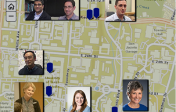Experiential Learning
Who's doing this at UT?
Experiential Learning is happening across UT, from the humanities to the sciences, professional fields to the arts; from classrooms to labs, studios to museums. Learn more about some of the instructors around UT who bring experiential learning into their classes.
How Can I Do This?
Experiential learning takes various shapes and takes place in various settings. As seen in this video, students can benefit from experiential learning at any stage of their development through any or many disciplinary pathways. But such an approach to teaching requires ample planning and guidance to ensure the highest chances for sucess. The following tips highlight the most important elements of the best experiential learning opportunities.
Prepare your course and your students for experiential learning.
Successful experiential learning requires just the right amount of structure to manage the complexities of open-ended, real world situations while helping students navigate their requirements and ambiguities.
- Align real-world encounters with the learning outcomes for your course so they are practicing and applying the most relevant knowledge and skills. Experiences should draw out or build on the underlying concepts, scholarship, and frameworks of your course.
- Plan ahead, especially when working with an external client. Be clear about expectations for timeline, deliverables, and roles. Anticipate disruptions and have alternative options in place.
- Determine the level of skills and knowledge students need to succeed at the more independent stages of experiential learning so you can structure your class to provide the appropriate level of support and guidance.
- Create opportunities for student agency throughout the process, letting students exercise choice and autonomy wherever possible and appropriate.
Take risks: Be open to risk-taking, both you and your students.
The first time teaching experiential learning, start modestly so everyone can enjoy the activity while deepening their learning. Remember, the results most likely will not be as predictable as you or your students are used to experiencing. The learning experiences help you teach the value of productive failure.
- Keep in mind that It’s about the process as much as the product.
- Find ways to involve external agents at some point in the learning process. This adds more variables to manage and raises the stakes, but infuses the work with authenticity and extends the impact beyond the class.
- Maintain open and frequent communication with your students so they — and you — can respond constructively to challenges and setbacks along the way.
- Whether successful or a "failure," help students document, reflect upon, and learn from the experience.
Emphasize student reflection throughout the learning process.
Experiential learning is a process, and although the product is important, regularly reflecting on the process and what they have learned is very important for students' growth.
Why Is This Important?
Learning that is considered "experiential" contains all the following elements: reflection, critical analysis and synthesis, opportunities for students to take initiative, make decisions and be accountable for the results. It provides opportunities for students to engage intellectually, creatively, emotionally, socially, or physically.
Increases student motivation to learn.
When students are engaged in learning experiences that they see the relevance of, and the product has more significance than a grade, they have increased motivation to learn and produce a more thoughtful product.
Produces more autonomous learners.
To solve problems and complete tasks in unfamiliar situations in a real-world context, students need to figure out what they know, what they do not know, and how to learn it.
Reflection deepens learning and helps students to:
Internships and work experience become more meaningful if students are better prepared.
Integrating experiential learning into content courses builds skills, confidence, and expectations for students to participate in successful internships and work experience.
- Students get more out of internships and work experiences if they learn beforehand certain attitudes and ways of thinking that are inherent in the discipline or the workplace.
- Experiential learning gives students the opportunity to practice and develop attitudes such as resilience, tenacity, curiosity and self-direction.
Most transferable and marketable skills are forged in “real world” settings.
Real-world competencies such as civic engagement, team work, and leadership that most employers look for in candidates, are best practiced in the “real-world” not sitting in a classroom.
Our students have the chance to access world-class research, development, and scholarly activities.
The resources we have here at UT Austin, both infrastructure and personnel, make this a rich, vibrant environment for students to be involved in many different areas without even leaving campus:
Explore More

Experiential Learning @ UT
Instructors across UT provide a wide range of learning opportunities that engage students in real-world experiences.

Deeper Dive Instructional Guide
This DDIG delves into what is experiential learning, why should we use this approach, and how it can be taught in our regular courses.

Experiential Learning at UT Map
Case studies and examples of instructors doing experiential learning around UT.

